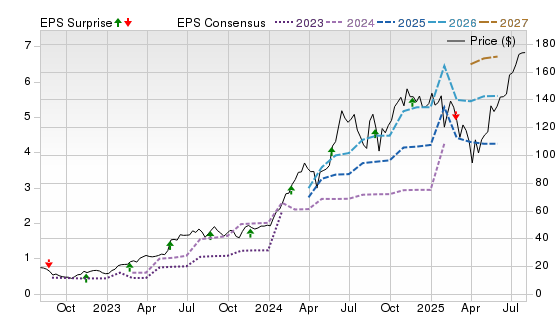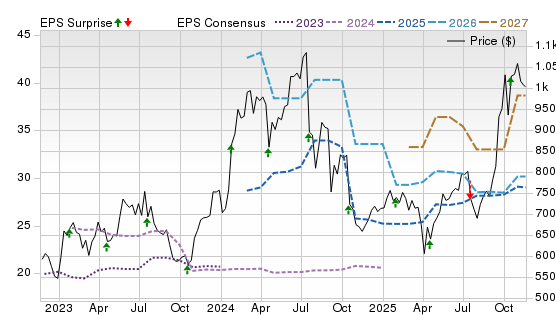5 Best Quantum Computing Stocks to Buy Today
| Company (Ticker) | 12 Week Price Change | Forward PE | Price | Proj EPS Growth (1 Year) | Projected Sales Growth (1Y) |
|---|---|---|---|---|---|
| Micron Technology (MU) | 89.51% | 13.08 | $230.26 | 107.10% | 46.52% |
| Teradata (TDC) | 37.48% | 11.90 | $28.26 | -0.99% | -6.44% |
| NVIDIA (NVDA) | 4.12% | 38.48 | $180.26 | 54.54% | 61.21% |
| Teradyne (TER) | 39.02% | 47.78 | $179.38 | 8.97% | 8.06% |
| ASML Holding (ASML) | 38.21% | 34.59 | $1,040.97 | 39.31% | 23.21% |
*Updated on November 26, 2025.
Micron Technology (MU)
$230.26 USD +5.73 (2.55%)
3-Year Stock Price Performance

Premium Research for MU
- Zacks Rank
- Strong Buy 1
- Style Scores
C Value A Growth B Momentum A VGM
- Market Cap:$252.40B (Large Cap)
- Projected EPS Growth:107.12%
- Last Quarter EPS Growth:65.32%
- Last EPS Surprise5.94%
- Next EPS Report date: Dec. 17, 2025
Our Take:
Micron is a top global supplier of DRAM and NAND memory and has rapidly become a key supplier of HBM for AI data centers. Industry research points to growing work on cryogenic memories to support quantum control electronics, a direction that aligns with Micron’s low-power and high-performance memory roadmap.
Fundamentals are improving around AI demand. Micron’s latest quarter delivered record revenue with a margin inflection and guidance for further sequential growth as HBM3E ramps for leading accelerators. Scale, domestic capacity, and CHIPS-enabled investments support mix and pricing as data-center upgrades continue.
A Zacks Rank #1 (Strong Buy) with Growth score A and Momentum score B, but Value score C fits a recovery profile that’s no longer inexpensive. On the Price, Consensus & EPS Surprise chart, shares trend higher while 2026–2027 EPS estimates lift after a mid-cycle trough, reinforcing the case that memory tailwinds are still building.
Teradata (TDC)
$28.26 USD -0.24 (-0.84%)
3-Year Stock Price Performance

Premium Research for TDC
- Zacks Rank
 Strong Buy 1
Strong Buy 1
- Style Scores
B Value D Growth D Momentum D VGM
- Market Cap:$2.66B (Mid Cap)
- Projected EPS Growth-0.83%
- Last Quarter EPS Growth: 128.57%
- Last EPS Surprise: 35.85%
- Next EPS Report date: Feb. 10, 2026
Our Take:
Teradata runs a multi-cloud data and analytics platform (VantageCloud) that enterprises use to operationalize AI today and, increasingly, to orchestrate hybrid workflows. Its platform is being integrated with NVIDIA’s AI software and accelerated computing to power more demanding workloads.
The company is methodically shifting to recurring, cloud ARR. It is positioning its data platform for agentic-AI use cases that require high-throughput, context-rich queries, capabilities that are also prerequisites for future hybrid quantum-classical analytics.
A Zacks Rank #1 signals upward estimate momentum despite Style Scores of D for both Growth and Momentum, which capture near-term choppiness. The Value score B indicates better relative valuation versus software peers during the transition. On the chart, price broke out as 2026–2027 EPS lines stepped higher from mid-2025 lows. The rebound in forward consensus is doing the heavy lifting, typical of a turn in a subscription pivot.
NVIDIA (NVDA)
$180.26 USD +2.44 (1.37%)
3-Year Stock Price Performance

Premium Research for NVDA
- Zacks Rank
 Strong Buy 1
Strong Buy 1
- Style Scores
F Value B Growth A Momentum C VGM
- Market Cap:$4,321.03B (Large Cap)
- Projected EPS Growth: 54.52%
- Last Quarter EPS Growth: 25.25%
- Last EPS Surprise:4.84%
- Next EPS Report date:Feb. 25, 2026
Our Take:
NVIDIA designs the GPUs and networking that dominate AI compute and leads quantum-adjacent software with CUDA-Q and cuQuantum, which let developers program hybrid CPU-GPU-QPU workflows and accelerate quantum circuit simulation, acting as key bridges until fault-tolerant quantum hardware arrives.
In the latest quarter, NVIDIA posted record revenue and data-center sales, guided higher for next quarter, and highlighted sustained demand for Blackwell-era platforms while funding continued investment in CUDA Q and quantum-accelerated research stacks. Financial momentum and software ecosystems reinforce durable advantages across accelerated and hybrid computing.
A Zacks Rank #1 reflects strong estimate revisions. Style Scores of A for Momentum and B for Growth reflect improvement as earnings expand, while the Value score of F flags a premium multiple that assumes execution. On NVDA’s chart, price rides a steady uptrend alongside rising multi-year EPS estimates, with 2026–2027 revisions stair-stepping higher, a visual of broadening consensus around sustained earnings power.
Teradyne (TER)
$179.38 USD +11.71 (6.98%)
3-Year Stock Price Performance

Premium Research for TER
- Zacks Rank
 Buy 2
Buy 2
- Style Scores
D Value F Growth D Momentum F VGM
- Market Cap: $26.26B (Large Cap)
- Projected EPS Growth:9.01%
- Last Quarter EPS Growth:49.12%
- Last EPS Surprise: 8.97%
- Next EPS Report date: Feb 4, 2026
Our Take:
Teradyne supplies automated test equipment used for complex SoCs and high-performance devices. Its precision test know-how is increasingly relevant to cryogenic control chips and RF electronics that sit around emerging quantum processors, where scalable measurement and validation are bottlenecks.
Q3 2025 results highlight solid revenues, with Semiconductor Test as the growth engine, as leading-edge nodes and advanced packaging lift demand. While robotics remains cyclical, test intensity in AI accelerators and specialized silicon should support utilization until handset and auto cycles fully normalize.
A Zacks Rank of #2 (Buy) reflects positive estimate revisions, but the Style Scores of D for Value and Momentum, and F for Growth highlight cyclical test demand and investment needs ahead of a broader recovery. On TER’s chart, 2025–2026 EPS estimates drifted lower through much of the year but began to stabilize into 2027. The stock’s choppy range reflects that transition from trough to early recovery.
ASML Holding (ASML)
$1,040.97 USD +37.75 (3.76%)
3-Year Stock Price Performance

Premium Research for ASML
- Zacks Rank
 Buy 2
Buy 2
- Style Scores
F Value F Growth B Momentum F VGM
- Market Cap:$394.55B (Large Cap)
- Projected EPS Growth: 39.29%
- Last Quarter EPS Growth:40.88%
- Last EPS Surprise:2.23%
- Next EPS Report date: Feb. 4, 2026
Our Take:
ASML is the sole provider of Extreme Ultraviolet (EUV) lithography tools and is now shipping High-NA EUV, equipment essential to pattern the most advanced logic, a foundation for both AI accelerators and silicon-based quantum devices. Industry discussions increasingly link lithography roadmaps to AI and quantum scaling.
Latest results showed solid Q3 2025 sales, 51.6% gross margin, healthy EUV bookings, and stronger Q4 guidance, underscoring demand from leading foundries preparing next-gen nodes. Installed-base services add resilience while High-NA adoption supports multi-year growth visibility.
A Zacks Rank #2 points to constructive revisions while Style Scores of F for Value and Growth reflect a premium multiple and near-term growth uncertainty. However, a Momentum score of B captures improving sentiment tied to High-NA adoption. On the chart, 2027 EPS estimates inflect higher as orders and guidance improved, and the price has pushed toward highs, mirroring confidence that capex for advanced nodes remains intact.
Methodology
The Zacks Rank is a proprietary stock-rating model that uses trends in earnings estimate revisions and earnings-per-share (EPS) surprises to classify stocks into five groups: #1 (Strong Buy), #2 (Buy), #3 (Hold), #4 (Sell) and #5 (Strong Sell). The Zacks Rank is calculated through four primary factors related to earnings estimates: analysts' consensus on earnings estimate revisions, the magnitude of revision change, the upside potential and estimate surprise (or the degree in which earnings per share deviated from the previous quarter).
Zacks builds the data from 3,000 analysts at over 150 different brokerage firms. The average yearly gain for Zacks Rank #1 (Strong Buy) stocks is +23.62% per year from January, 1988, through June 2, 2025.
Selections for Best Quantum Computing Stocks are based on the current top ranking stocks based on Zacks Indicator Score. For this list, only companies that have average daily trading volumes of 100,000 shares or more and at least five analysts covering the stock were considered. All information is current as of market open, Nov. 26, 2025.
Introduction to Quantum Computing Stocks
What Are Quantum Computing Stocks?
Quantum computing stocks are publicly traded companies that develop quantum hardware, quantum software, or platforms that allow customers to access quantum systems. These firms range from early-stage, pure-play quantum companies to tech giants that treat quantum computing as part of a broader innovation portfolio.
Quantum computing companies fall into several distinct categories. Understanding these groups—and which stocks belong to each—helps investors target the level of risk and exposure they want.
1. Pure-Play Quantum Hardware Companies
These companies focus almost entirely on building quantum computers and related systems. They generate most of their revenue from quantum technology rather than broader tech operations.
Examples:
- IonQ (IONQ) – Specializes in trapped-ion quantum computers with cloud access via AWS, Azure, and Google Cloud.
- Rigetti Computing (RGTI) – Builds superconducting quantum processors and hybrid quantum–classical platforms.
- D-Wave Quantum (QBTS) – Develops quantum annealing systems optimized for real-time optimization tasks.
These companies offer the highest direct exposure to quantum technology, but also carry the most risk and volatility.
2. Quantum Software & Algorithm Developers
These firms build software tools, algorithms, and operating environments that run on quantum hardware, often partnering with multiple hardware providers.
Examples:
- Quantum Computing Inc. (QUBT) – Develops photonic-based systems and reservoir computing models along with software tools for quantum applications.
- Horizon Quantum Computing (Private) – Works on compiling classical code into quantum-ready programs.
- Zapata AI (Private, formerly Zapata Computing) – Focuses on quantum-inspired optimization and machine-learning software.
Though many quantum software leaders are still private, companies like QUBT give public investors access to this segment.
3. Hybrid or Quantum-Adjacent Computing Companies
These firms don’t build full quantum computers but develop technologies that support or complement quantum computing, such as photonics, cryogenics, advanced sensors, or quantum communication systems.
Examples:
- Nvidia (NVDA) – Provides GPU platforms that power quantum simulations and hybrid quantum–classical workflows.
- Adtran (ADTN) – Develops quantum-safe networking solutions.
- Hamamatsu Photonics (HPHTF) – Manufactures detectors and lasers used in quantum research.
- Arqit Quantum (ARQQ) – Specializes in quantum encryption and quantum-safe security.
These stocks offer exposure to the broader quantum ecosystem with lower technological risk.
4. Large-Cap Technology Companies With Quantum Divisions
These tech giants invest heavily in quantum computing R&D as part of their broader innovation strategy. Their quantum operations are small relative to total revenue, but their resources make them long-term contenders.
Examples:
- Alphabet (GOOGL) – Google Quantum AI leads in superconducting qubit research and error correction breakthroughs.
- IBM (IBM) – Operates one of the world’s largest quantum ecosystems with IBM Quantum and a multi-year quantum development roadmap.
- Microsoft (MSFT) – Develops topological qubits and runs the Azure Quantum cloud platform.
- Amazon (AMZN) – Provides quantum access through AWS Braket and invests in multiple quantum hardware startups.
These companies offer the safest quantum exposure because their success does not depend solely on quantum breakthroughs.
Practical Use Cases and Near-Future Applications
Quantum computing is expected to disrupt industries that depend on immense computational power. While fully fault-tolerant systems may still be years away, several near-term applications are starting to emerge:
- Optimization problems (logistics, supply chain, routing).
- Drug discovery & materials science.
- Financial modeling, risk analysis & portfolio optimization.
- AI acceleration via quantum-enhanced machine learning.
- Cybersecurity & post-quantum cryptography.
Hybrid quantum-classical systems — already accessible via cloud platforms — are likely to be the earliest source of commercial value.
Is It Too Early to Invest in Quantum Computing Stocks Now?
Quantum computing is still in its infancy. For many investors, this raises a fair question: Is now the right time—or too soon—to buy quantum stocks?
Why It Might Be Too Early
- Many quantum companies are unprofitable and years from commercial-scale revenue.
- Stock prices tend to swing sharply on small news events.
- Quantum hardware still faces challenges like error correction and qubit stability.
Why Some Investors Are Buying Now
- Governments and corporations are investing heavily, accelerating progress.
- Several quantum companies now have real customers and recurring revenue.
- Major breakthroughs could significantly revalue early-stage players.
- Wall Street analysts are increasingly bullish on select names.
Bottom line: Quantum stocks are a high-risk, long-term bet — similar to early semiconductor or AI companies decades ago. Investors with patience and risk tolerance may see significant upside.
Pros and Cons of Investing in Quantum Computing Stocks
Benefits of Buying Quantum Computing Stocks
- Potential for exponential long-term returns
- Exposure to a transformative next-generation technology
- Early participation in a market that could rival today’s semiconductor or AI industries
- Increasing institutional interest and government funding
Risks of Buying Quantum Computing Stocks
- Many companies have uncertain business models
- High volatility and frequent price spikes/drops
- Long timelines for commercial viability
- Unproven technologies may never reach scale
- Cash burn and capital-raising risks
Are Quantum Computing Stocks a Good Long-Term Investment?
Quantum stocks can be an excellent long-term play if you:
- Can tolerate long periods of volatility
- Want exposure to frontier technologies
- Have a multi-year investment horizon
- Understand that profitability may be far off
For conservative investors, a diversified tech name like Alphabet offers safer quantum exposure.
Investing in Quantum Computing Stocks
How Do You Invest in Quantum Computing Stocks?
- Buy shares directly through a brokerage.
- Use thematic ETFs with exposure to quantum and advanced computing.
- Consider fractional shares to reduce risk in volatile names.
How to Select the Best Quantum Computing Stocks
Look for:
- Technological roadmaps — Qubit count, error rates, scalability.
- Commercial traction — Customers, recurring revenue, cloud deployments.
- Strong partnerships — Government, enterprise, and strategic alliances.
- Financial health — Cash reserves and sustainable burn rates.
- Analyst ratings and price targets — Look at what analysts covering the stock say and prediction for future share prices.
Market Timing and Future Outlook
When Will Quantum Computing Be Commercially Viable?
Most experts predict:
- Early commercial applications: Within 2–5 years.
- Broader enterprise deployment: Within 5–10 years.
- Fully fault-tolerant quantum systems: Likely 10+ years away.
Progress is accelerating, but meaningful revenue at industrial scale may take time.
Key Technological Breakthroughs to Watch
- Improvements in quantum error correction.
- Advances in qubit stability and coherence.
- Achieving quantum advantage in real-world tasks.
- Expansion of quantum cloud services.
- Launch of commercial-grade next-generation quantum processors.
- Cross-industry partnerships in AI, pharmaceuticals, and logistics.














